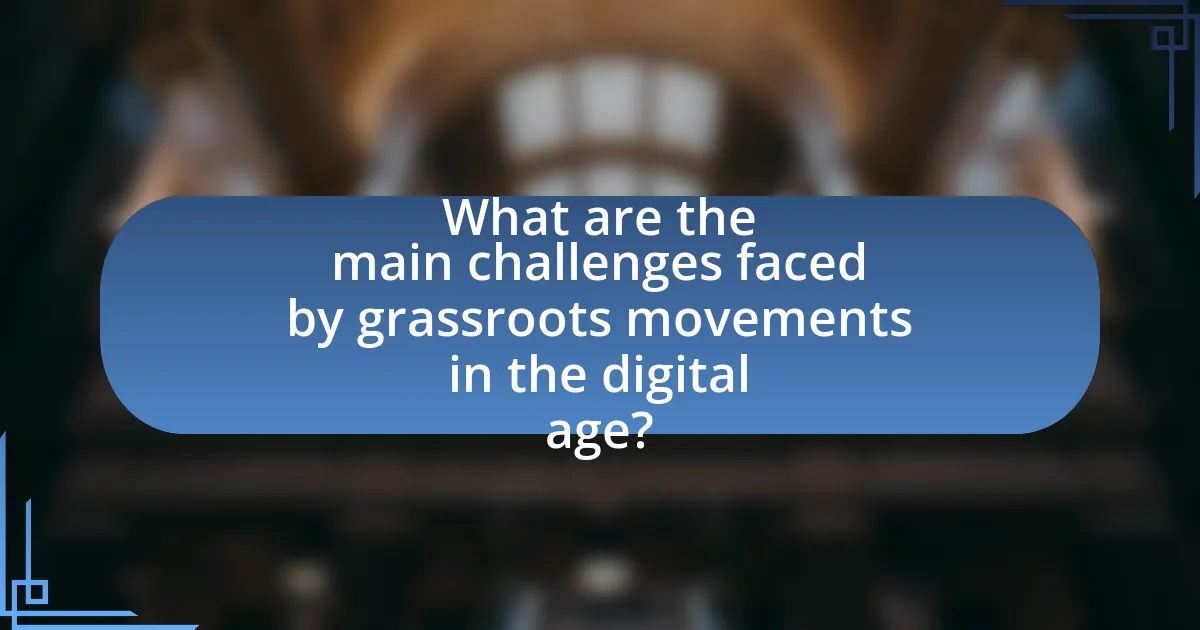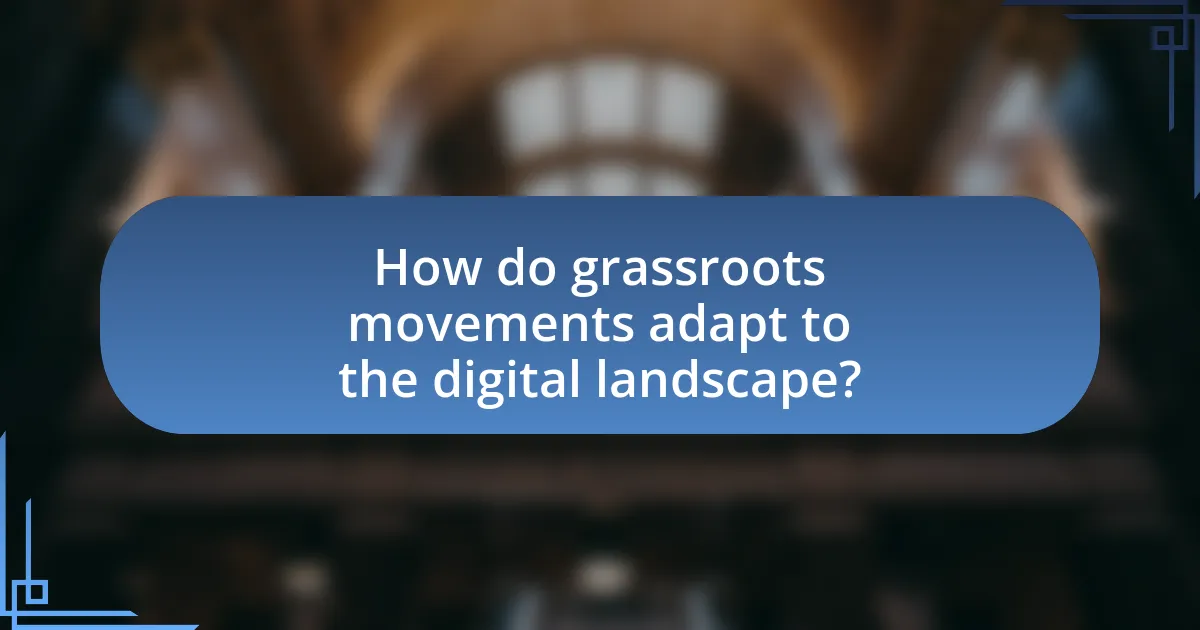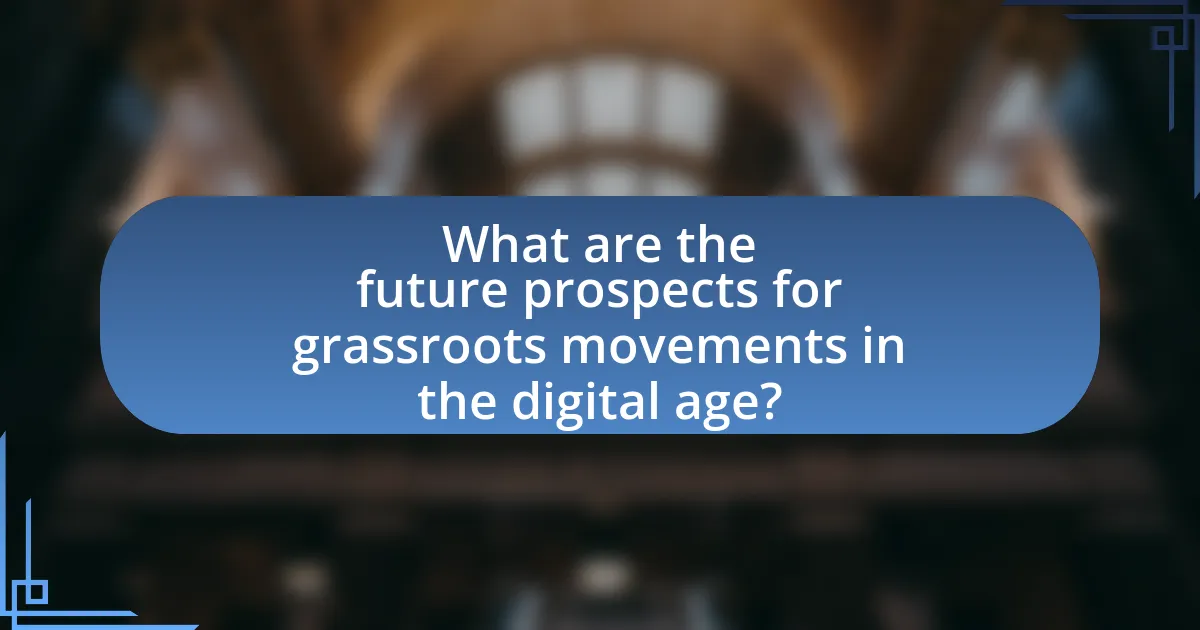Grassroots movements in the digital age encounter various challenges, including information overload, digital surveillance, and fragmentation of attention, which hinder their effectiveness in advocating for social change. Technology has transformed these movements by enhancing communication and mobilization, yet obstacles such as algorithmic bias and misinformation persist. The article explores the impact of social media on grassroots mobilization, the role of digital platforms in community engagement, and strategies for overcoming online challenges. Additionally, it discusses how grassroots movements can leverage technology for fundraising, build coalitions, and prepare for future digital challenges, ultimately highlighting best practices for success in a rapidly evolving digital landscape.

What are the main challenges faced by grassroots movements in the digital age?
Grassroots movements in the digital age face significant challenges, including information overload, digital surveillance, and fragmentation of attention. Information overload occurs as activists struggle to cut through the vast amount of content online, making it difficult to engage supporters effectively. Digital surveillance poses a risk to privacy and security, as movements are often monitored by governments or opposing entities, which can lead to repression. Fragmentation of attention results from the multitude of platforms and competing messages, making it challenging for grassroots movements to maintain a cohesive narrative and mobilize supporters. These challenges hinder the effectiveness and sustainability of grassroots efforts in advocating for social change.
How has technology impacted grassroots movements?
Technology has significantly enhanced grassroots movements by facilitating communication, organization, and mobilization. Social media platforms like Twitter and Facebook allow activists to reach a wider audience quickly, enabling rapid dissemination of information and coordination of events. For instance, the Arab Spring in 2011 demonstrated how social media could mobilize protests and share real-time updates, leading to significant political changes in several countries. Additionally, crowdfunding platforms have empowered grassroots organizations to raise funds directly from supporters, bypassing traditional funding sources. This shift has democratized financial support, allowing movements to thrive without reliance on large donors. Overall, technology has transformed grassroots movements into more agile and connected entities, increasing their impact and reach.
What role does social media play in grassroots mobilization?
Social media serves as a crucial tool for grassroots mobilization by facilitating rapid communication and organization among supporters. It enables movements to disseminate information quickly, engage with a broader audience, and coordinate actions effectively. For instance, during the Arab Spring, platforms like Twitter and Facebook were instrumental in organizing protests and sharing real-time updates, demonstrating how social media can amplify grassroots efforts and mobilize large groups of people. Additionally, studies indicate that social media can increase participation rates in grassroots campaigns, as seen in the 2018 U.S. midterm elections, where online engagement significantly contributed to higher voter turnout among younger demographics.
How do digital platforms influence community engagement?
Digital platforms significantly enhance community engagement by providing accessible channels for communication and collaboration. These platforms facilitate real-time interaction among community members, allowing for the rapid dissemination of information and mobilization around shared causes. For instance, studies show that social media platforms like Facebook and Twitter have been instrumental in organizing grassroots movements, evidenced by events such as the Arab Spring, where online communication played a crucial role in rallying support and coordinating protests. Additionally, research from the Pew Research Center indicates that 69% of adults in the U.S. use social media, highlighting its pervasive influence in fostering community connections and engagement.
What obstacles do grassroots movements encounter online?
Grassroots movements encounter several obstacles online, including algorithmic bias, misinformation, and digital surveillance. Algorithmic bias can limit the visibility of their content on social media platforms, as algorithms often favor established voices over emerging movements. Misinformation campaigns can undermine their credibility and confuse potential supporters, making it difficult to convey their messages effectively. Additionally, digital surveillance poses a threat to activists’ privacy and security, potentially deterring participation and open communication. These challenges are supported by research indicating that social media algorithms disproportionately favor larger organizations, while studies show that misinformation can significantly impact public perception and engagement.
How does misinformation affect grassroots initiatives?
Misinformation significantly undermines grassroots initiatives by eroding trust and distorting public perception. When false information circulates, it can lead to confusion among supporters and potential allies, causing them to question the credibility of the initiative. For instance, a study by the Pew Research Center found that 64% of Americans believe that misinformation has a major impact on public opinion, which directly affects grassroots movements that rely on community support and engagement. Additionally, misinformation can divert resources and attention away from the core objectives of these initiatives, as organizers may need to spend time and effort countering false narratives instead of focusing on their goals.
What are the challenges of digital privacy and security?
Digital privacy and security face significant challenges, primarily due to data breaches, surveillance, and inadequate regulations. Data breaches expose sensitive information, with a report from IBM indicating that the average cost of a data breach in 2023 is $4.45 million. Surveillance practices by governments and corporations compromise individual privacy, as evidenced by the widespread use of tracking technologies and data collection methods. Furthermore, existing regulations often lag behind technological advancements, leaving gaps in protection for individuals and organizations. These factors collectively hinder the ability of grassroots movements to operate securely and maintain the confidentiality of their communications and strategies.

How do grassroots movements adapt to the digital landscape?
Grassroots movements adapt to the digital landscape by leveraging social media platforms and online tools for organization, communication, and mobilization. These movements utilize platforms like Facebook, Twitter, and Instagram to reach wider audiences, disseminate information rapidly, and engage supporters in real-time. For instance, the Black Lives Matter movement effectively used Twitter to organize protests and share information, resulting in a significant increase in visibility and support. Additionally, grassroots movements often employ crowdfunding platforms to finance their initiatives, allowing them to bypass traditional funding sources. This adaptation to digital tools enhances their ability to respond to challenges and mobilize resources efficiently in a rapidly changing environment.
What strategies do grassroots movements employ to overcome digital challenges?
Grassroots movements employ strategies such as leveraging social media, building digital literacy, and fostering community engagement to overcome digital challenges. By utilizing platforms like Facebook and Twitter, these movements can amplify their messages and mobilize supporters quickly. Additionally, they often conduct workshops to enhance digital skills among members, ensuring effective communication and outreach. Community engagement through local events and online forums helps to create a supportive network, enabling grassroots movements to adapt to the rapidly changing digital landscape. These strategies have been evidenced by successful campaigns, such as the Black Lives Matter movement, which effectively used social media to raise awareness and drive action.
How can grassroots movements leverage technology for fundraising?
Grassroots movements can leverage technology for fundraising by utilizing online platforms and social media to reach a broader audience and facilitate donations. For instance, crowdfunding websites like GoFundMe and Kickstarter allow grassroots organizations to create campaigns that can be shared widely, increasing visibility and potential contributions. Additionally, social media platforms such as Facebook and Instagram enable movements to engage with supporters directly, share their mission, and encourage donations through integrated fundraising tools. According to a 2021 report by the Pew Research Center, 53% of Americans have donated to a crowdfunding campaign, highlighting the effectiveness of these platforms in mobilizing financial support for grassroots initiatives.
What are effective methods for online advocacy and awareness?
Effective methods for online advocacy and awareness include leveraging social media platforms, creating engaging content, and utilizing email campaigns. Social media platforms like Facebook, Twitter, and Instagram allow grassroots movements to reach a broad audience quickly; for instance, a study by Pew Research Center found that 69% of adults in the U.S. use social media, making it a vital tool for engagement. Creating engaging content, such as videos and infographics, can increase shareability and visibility; research indicates that visual content is 40 times more likely to be shared on social media than other types of content. Email campaigns can also effectively mobilize supporters and disseminate information, with a report from Campaign Monitor showing that email marketing has an average ROI of 4400%. These methods collectively enhance the reach and impact of online advocacy efforts.
How do grassroots movements build coalitions in the digital age?
Grassroots movements build coalitions in the digital age by leveraging social media platforms and online communication tools to connect diverse groups and amplify their messages. These movements utilize platforms like Twitter, Facebook, and Instagram to reach a wider audience, mobilize supporters, and coordinate actions quickly. For instance, the #MeToo movement effectively united individuals across various demographics by sharing personal stories and creating a collective identity, demonstrating the power of digital connectivity in fostering solidarity. Additionally, data from the Pew Research Center indicates that 69% of adults in the U.S. use social media, providing a vast network for grassroots organizations to engage and organize.
What platforms facilitate collaboration among grassroots organizations?
Platforms that facilitate collaboration among grassroots organizations include Slack, Trello, and Facebook Groups. These platforms enable real-time communication, project management, and community engagement, which are essential for grassroots movements. For instance, Slack allows teams to create channels for specific topics, enhancing focused discussions, while Trello provides a visual project management tool that helps organizations track tasks and deadlines. Facebook Groups offer a space for community building and sharing resources, making it easier for grassroots organizations to connect with supporters and collaborate on initiatives.
How can grassroots movements engage with larger networks online?
Grassroots movements can engage with larger networks online by leveraging social media platforms to amplify their message and connect with like-minded organizations. Utilizing platforms such as Twitter, Facebook, and Instagram allows these movements to reach broader audiences, share resources, and collaborate on campaigns. For instance, the #MeToo movement effectively utilized social media to connect individuals and organizations globally, demonstrating the power of online engagement in raising awareness and fostering solidarity. Additionally, grassroots movements can participate in online forums and webinars to share knowledge and strategies, further integrating into larger networks.

What are the future prospects for grassroots movements in the digital age?
The future prospects for grassroots movements in the digital age are promising due to enhanced connectivity and access to information. Digital platforms enable grassroots organizations to mobilize supporters quickly, share resources, and amplify their messages globally. For instance, the rise of social media has allowed movements like Black Lives Matter to gain international attention and support, demonstrating the power of digital tools in grassroots activism. Additionally, data from the Pew Research Center indicates that 69% of Americans use social media, providing a vast audience for grassroots initiatives. This connectivity fosters collaboration and solidarity among diverse groups, increasing the potential for impactful social change.
How might emerging technologies shape grassroots activism?
Emerging technologies significantly shape grassroots activism by enhancing communication, mobilization, and resource accessibility. For instance, social media platforms enable activists to reach wider audiences quickly, facilitating the rapid dissemination of information and rallying support for causes. According to a study by the Pew Research Center, 69% of adults in the U.S. use social media, which underscores its potential as a tool for organizing protests and campaigns. Additionally, technologies like crowdfunding platforms allow grassroots movements to secure funding directly from supporters, bypassing traditional financial barriers. This democratization of resources empowers smaller organizations to compete with larger entities, thereby amplifying their impact.
What potential do artificial intelligence and data analytics hold for grassroots movements?
Artificial intelligence and data analytics hold significant potential for grassroots movements by enhancing their ability to mobilize supporters, analyze public sentiment, and optimize resource allocation. These technologies enable grassroots organizations to process large volumes of data, identify trends, and tailor their messaging to resonate with specific audiences. For instance, AI-driven tools can analyze social media interactions to gauge public opinion on issues, allowing movements to adapt their strategies in real-time. Additionally, data analytics can help in identifying key demographics and geographic areas for targeted outreach, increasing the effectiveness of campaigns. A study by the Stanford Social Innovation Review highlights that organizations leveraging data analytics saw a 30% increase in engagement rates, demonstrating the tangible benefits of these technologies in grassroots efforts.
How can grassroots movements prepare for future digital challenges?
Grassroots movements can prepare for future digital challenges by adopting robust digital literacy programs and enhancing their online security measures. Digital literacy enables activists to effectively navigate social media platforms, utilize data analytics for outreach, and engage with diverse audiences. For instance, a study by the Pew Research Center in 2021 found that 53% of Americans believe social media is an important tool for activism, highlighting the necessity for grassroots organizations to be proficient in these digital spaces. Additionally, implementing strong cybersecurity protocols protects sensitive information and maintains trust within the community. According to a report by Cybersecurity & Infrastructure Security Agency (CISA), organizations that prioritize cybersecurity are 50% less likely to experience data breaches, underscoring the importance of these measures for grassroots movements in the digital age.
What best practices can grassroots movements adopt for success in the digital age?
Grassroots movements can adopt several best practices for success in the digital age, including leveraging social media for outreach, utilizing data analytics for targeted messaging, and fostering community engagement through interactive platforms. Social media platforms like Facebook and Twitter enable movements to reach a wider audience quickly, as evidenced by the rapid mobilization seen during events like the Arab Spring, where social media played a crucial role in organizing protests. Data analytics allows movements to tailor their messages to specific demographics, increasing the likelihood of engagement; for instance, campaigns that analyze user behavior can optimize their outreach strategies effectively. Additionally, interactive platforms such as online forums and webinars encourage community participation, creating a sense of ownership and commitment among supporters, which is vital for sustaining momentum.
How can grassroots movements effectively measure their digital impact?
Grassroots movements can effectively measure their digital impact by utilizing analytics tools to track engagement metrics such as website traffic, social media interactions, and email open rates. These metrics provide quantitative data that reflects the reach and effectiveness of their digital campaigns. For instance, platforms like Google Analytics can reveal user behavior on websites, while social media insights can show the number of shares, likes, and comments, indicating audience engagement. Additionally, surveys and feedback forms can be employed to gather qualitative data on audience perceptions and the overall impact of digital initiatives. This combination of quantitative and qualitative analysis allows grassroots movements to assess their digital strategies and make informed adjustments to enhance their outreach and effectiveness.
What resources are available for grassroots movements to enhance their digital strategies?
Grassroots movements can enhance their digital strategies through various resources, including social media platforms, digital marketing tools, online training programs, and community engagement software. Social media platforms like Facebook, Twitter, and Instagram allow grassroots organizations to reach wider audiences and mobilize supporters effectively. Digital marketing tools such as Mailchimp and Hootsuite facilitate campaign management and audience targeting. Online training programs, offered by organizations like the Nonprofit Technology Network, provide essential skills in digital advocacy and fundraising. Community engagement software, such as NationBuilder, helps in organizing and managing supporter relationships. These resources collectively empower grassroots movements to navigate the digital landscape more effectively, enabling them to overcome challenges and amplify their impact.


